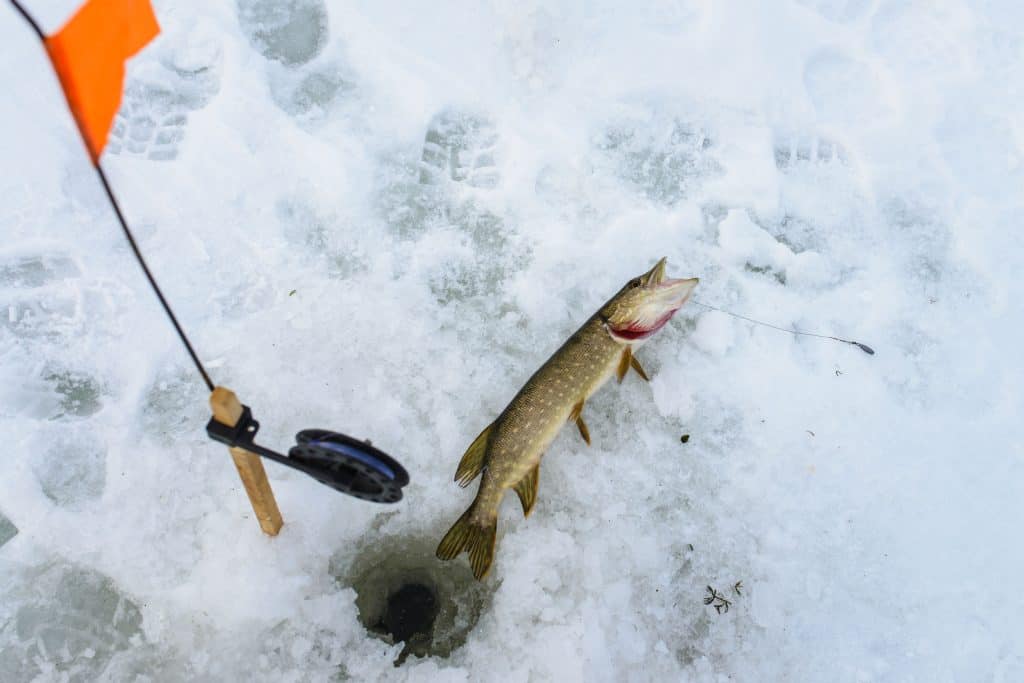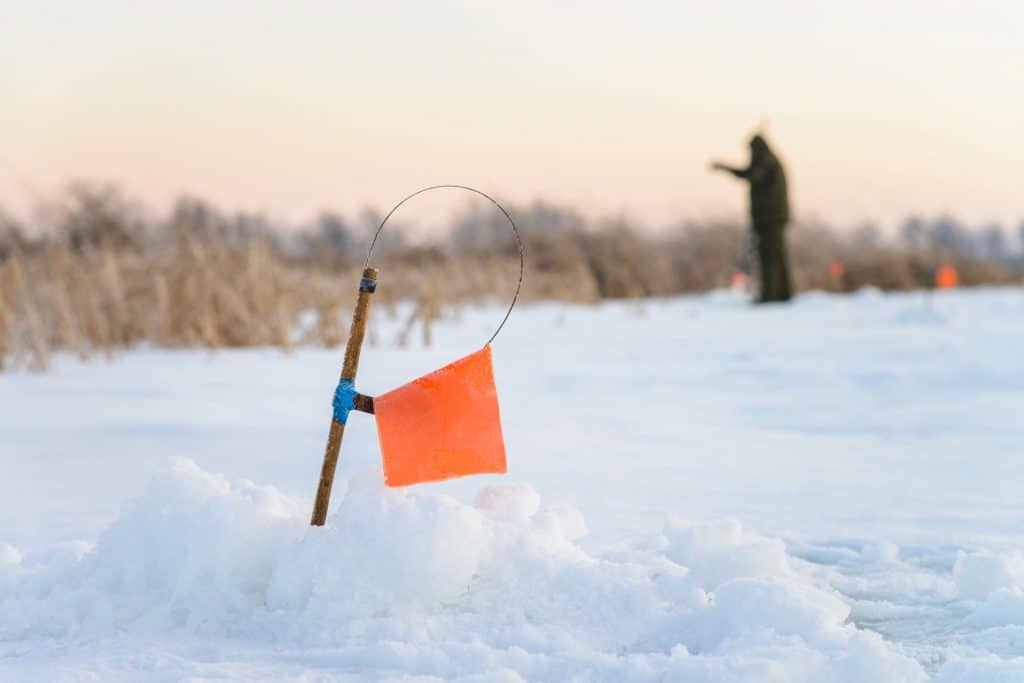There are many useful tools to help you when ice fishing. One that you may have never heard of before, if you are new to this activity, is called a tip-up. I’m going to provide a simple introduction to tip-ups.
A tip-up is a device that suspends bait underneath the ice. The fisherman can set one in a place and simply wait. When a fish takes the bait and begins to swim away, a flag is activated on the surface, alerting the fisherman. He can then start reeling the fish in.
Using tip-ups isn’t difficult, and there are a ton of advantages to them compared to normal fishing rods.

Why Tip-Ups Are Useful
While normally a fisherman must hold a fishing rod to try to catch the attention of fish, a tip-up sits on top of a hole in the ice and suspends a line beneath the water. Immediately, you might see one clear advantage: the fisherman can now have his hands free.
Being able to set a trap and then just relax until it catches something? That sounds pretty nice to me!
Once the tip-up’s flag goes up, the fisherman will have to do all the work of bringing the fish up himself, of course. If it’s a big fish, this can be quite a task, but it’s the sort of challenge that many love to experience.
Using tip-ups when ice fishing can make for a session of alternating between simple moments of relaxation and those intense battles of man versus fish.
Now, you may have realized by this point that if you don’t have to hold the tip-up to use it, that means you can pretty much place as many tip-ups down as you want. That is absolutely true. As many holes as you are willing to dig, and as many tip-ups as you have, you can have baited and in the water.
With that, tip-ups probably sound great to you. Think of the efficiency of being able to have many lines in the water at once. As flags go off, you just pull your catches in and prepare to put the tip-ups into action once more.
Do be aware, however, that there may be fishing regulations in your state that limits how many you can use. Always check those before you go.
That aside, if you’ve picked a good spot and have many tip-ups ready, you may have many flags going off in a short amount of time, so you’ll be bringing in fish with crazy efficiency.
Of course, if you’d rather just relax most of the time, you don’t have to dig so many holes. But those who are looking to catch as many fish as possible should get quite a few tip-ups, and if the fish are biting, they’ll be quite busy pulling them in and resetting their tip-ups.
Tip-ups offer a unique style of fishing. They’re devices that can only be used for ice fishing, as they are designed to suspend lines through small holes. They can result in you catching a lot of fish in a short amount of time. If you’re going ice fishing, you should definitely consider using them.
How To Use Tip-Ups
Tip-ups are not particularly complicated, so you’ll be able to learn to use one in no time.
Their designs vary a bit, but all of them are designed so that they can rest on a hole while dangling a fishing line underwater. There will be too important pieces attached to the main structure: a spool, which you use to handle your fishing line, and a flag, which will let you know when a fish bites.
First, you will need to fill the spool with fishing line. Make sure it’s tough enough for the big fish you may catch. Braided fishing line is particularly good for winter, as it does not get tangled easily. As with any fishing, obviously, you’ll need to get a hook at the end of that line.
With your line on the spool and your hook ready to go with bait on it, most of the prep work is already done. Just pull out the line to the length you want it to be at (think of how deep you want to fish), and after that, you will simply put the tip-up on top of the hole you’ve dug in the ice. The line will drop underwater and will hang there, waiting for a fish to bite.
At this point, make sure you put the flag down. You can’t be alerted to anything if the flag stays in the up position the whole time.
When a fish gives the hook a good tug, the spool will spin and trigger the flag to go up. The tip-up can’t bring in the fish for you, so this is when you need to come and pull it in yourself. This is something that’s not much different from any other kind of fishing.
Once you’ve brought the fish up to the surface and unhooked it, this is a process you can repeat easily. Eventually, you will run out of line on the spool, so you will have to look out for that.
So, using tip-ups is a straightforward process.
Of course, you are free to use a fishing rod on another hole if you want to keep busy.
Feel free to use many tip-ups, as I described earlier. Most of the work is simply in putting the lines on each one. Digging so many holes could be time-consuming as well, of course, but once you have both of those done, it’s an easy process that can help you to catch much fish.
However, it is important to remember that some areas have fishing regulations that may prevent you from using as many tip-ups as you want. Make sure to check those before you go crazy with tip-ups, or you could get in a bit of trouble.

Where To Find Tip-Ups
Tip-ups are widely available, so finding some won’t be hard.
If you know what you are looking for and want some impressive handcrafted ones, there are many small businesses out there selling their own custom-made tip-ups. This article recommends many. You know you’ll be getting a durable product when you buy from enthusiasts like these.
However, you will probably find it easier to look at bigger stores such as the following two from Amazon.

Get an inexpensive set of 3 tip-ups that includes a bonus minnow net.

Or, there’s a high-quality tip-up also available for a great price as well.
If you are looking for options besides Amazon, Bass Pro Shop is a good place to go. They have a few different options, some made of wood, others made of plastic. You can also try Dick’s Sporting Goods.
Tip-ups are a common item, so local fishing shops will almost certainly carry them, especially in the winter.
Wherever you look for tip-ups, you will want to consider the durability of the materials used. The parts most likely to break is the flag and the piece that sends it flying up, so pay special attention to those. The base of a tip=up is not likely to ever break.
Make sure the spool will stay attached too, of course. A tip-up that can’t hold fishing line is as useless as one that can’t alert you when it’s caught something.
Now, if you are the type of person who is good at making things, this is the sort of trap you could learn to make yourself. It could be a fun project, and would likely end up being the least expensive way to make several tip-ups.
The base would just require a few pieces of wood. The trickiest part is the mechanism that activates the flag. But as a pretty simple device, this is definitely something you can learn if you’re good with crafts.
For everyone else, though, just check out the stores listed above. For not too much money, you will be able to bring home more fish than ever. Just dig a bunch of holes, place tip-ups on each one, and wait for the magic to happen.
